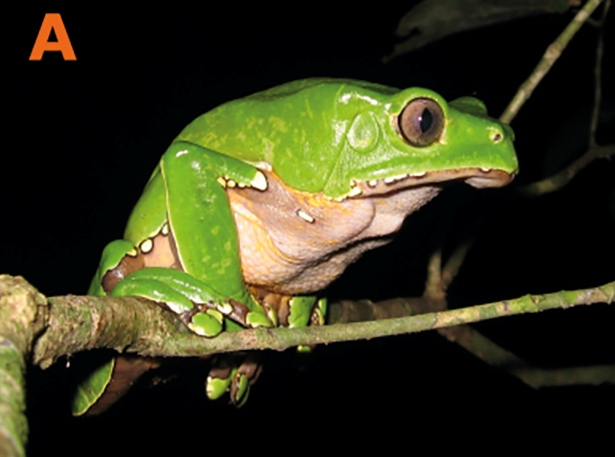Published: 2 March 2023
Publications
Kambô – leave it with frogs
Published: 2 March 2023
Prescriber Update 44(1): 4–6
March 2023
A case has been reported to the Centre for Adverse Reactions Monitoring
(CARM) where the individual developed hypersensitivity vasculitis in
relation to a Kambô ritual.
What is Kambô?
Kambô is a purifying ritual, which has a long history of use in South American traditional medicine. In the traditional Kambô ritual, a shaman uses a hot stick to create a series of small burns in the individual’s skin, and then applies a secretion from the frog species Phyllomedusa bicolor to the fresh wound.1,2
P. bicolor, also named the giant leaf frog, is widely distributed in the rainforests of the Amazon basin, including in Brazil, Colombia and Bolivia.1-3 The frog can be more than 10 centimetres long and is green with a white belly (Figure 1).1,3
As a defence mechanism, the frog produces a skin secretion that contains many different substances, such as alkaloids, peptides and proteins. The frog must be stressed to produce the secretion. For the traditional Kambô ritual, this is accomplished in different ways, such as tying the captured frog up and poking it. The secretion is then scraped from its skin and the frog is released.1,3
Figure 1: Image of the frog species Phyllomedusa bicolor

Source: Silva FVAD, Monteiro WM and Bernarde PS. 2019. "Kambô"
frog (Phyllomedusa bicolor): Use in folk medicine and potential
health risks. Revista da Sociedade Brasileira de Medicina
Tropical 52: e20180467. DOI: 10.1590/0037-8682-0467-2018.
Note that the original has been modified: only image A is shown;
images B, C and D are not.
Creative
Commons Attribution 4.0 International License.
No clinical evidence to support therapeutic claims
The Kambô ritual was originally performed by shamans in South American as a purification ritual for the indigenous tribes. Over time, some aspects of the ritual have been appropriated and used in countries throughout the world. With this spread, the reported reasons for use have increased and include claims of therapeutic benefits and healing properties.1-4
These claims have been made without supporting clinical evidence. No beneficial effects of the frog secretion have been scientifically tested or demonstrated in the literature.1,2
Side effects
Serious and life-threatening side effects have been reported following application of the frog secretion.1-5
A physiological reaction is induced within minutes of application, with effects such as tachycardia, intense vomiting and sweating. These effects generally subside in about an hour, followed by a state of apathy and drowsiness.1
The secretion contains a variety of peptides and other substances with intense pharmacological actions, including the opioid peptides deltorphin and dermorphin, as well as peptides with antimicrobial, gastrointestinal and cardiovascular effects.1,4
It has been suggested that most side effects of the secretion may be associated with the CNS depressant and cardiovascular effects of its peptides. Additionally, many side effects are thought to be dose dependent.1
Other side effects have been described in the literature. A published case report describes a 33-year-old female with a history of periodic use of frog secretion in Kambô rituals, who presented with asthenia, malaise and myalgia, and was diagnosed with dermatomyositis.5
A recent literature review of acute poisoning after application of frog secretions from Phyllomedusa bicolor reported numerous symptoms including vomiting, diarrhoea, epilepsy, muscle disorders, mood disturbances and hydroelectrolytic imbalance. Various Kambô-associated pathologies were also described, such as syndrome of inappropriate antidiuretic hormone secretion (SIADH), acute renal failure, dermatomyositis, rupture of oesophagus, severe psychosis, toxic hepatitis and death.4
Hyponatraemia may be associated with Kambô due to the development of SIADH and the common practice of ingesting large volumes of water as part of these rituals.4
Regulation
The frog secretion used in Kambô rituals is not an approved medicine in New Zealand, and therefore its safety, quality or effectiveness has not been assessed.
References
- Nogueira TAC, Kaefer IL, Sartim MA, et al. 2022. The Amazonian kambô frog Phyllomedusa bicolor (Amphibia: Phyllomedusidae): Current knowledge on biology, phylogeography, toxinology, ethnopharmacology and medical aspects. Frontiers in Pharmacology 13: 997318. URL: frontiersin.org/articles/10.3389/fphar.2022.997318/full (accessed 13 October 2022).
- den Brave PS, Bruins E, Bronkhorst MW. 2014. Phyllomedusa bicolor skin secretion and the Kambô ritual. Journal of Venomous Animals and Toxins including Tropical Diseases 20: 40. DOI: 10.1186/1678-9199-20-40. (accessed 14 December 2022).
- Junior VH, Martins IA. 2020. KAMBÔ: An Amazonian enigma. Journal of Venom Research 10:1 3-17. URL: ncbi.nlm.nih.gov/pmc/articles/PMC7284396/ (accessed 13 October 2022).
- Sacco MA, Zibetti A, Bonetta CF, et al. 2022. Kambô: Natural drug or potential toxic agent? A literature review of acute poisoning cases. Toxicology Reports 9:905-13. DOI: 10.1016/j.toxrep.2022.04.005 (accessed 13 October 2022).
- de la Vega M, Maldonado G, Kraus A. 2020. Dermatomyositis induced by the secretion of Phyllomedusa bicolor or Kambô frog - A case report. Toxicon Sep;184:57-61. DOI: 10.1016/j.toxicon.2020.05.018 (accessed 13 October 2022).





